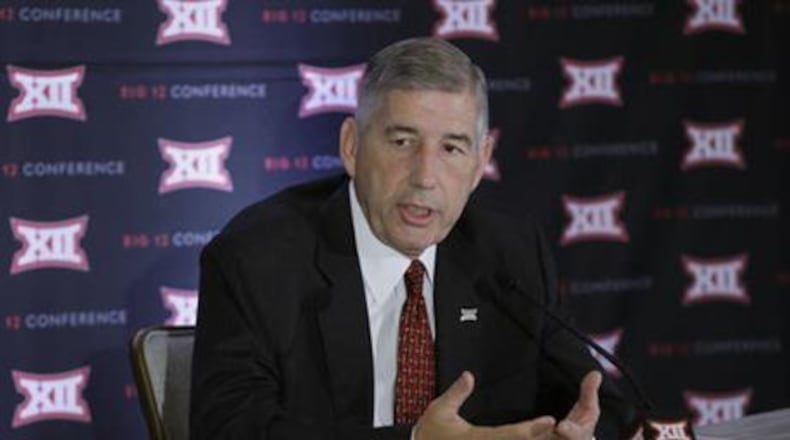A move portended by the league's revival of its championship game last week at its spring meetings in Irving, Texas — is a move done merely for show, seeing as it does little to alter the championship structure set in place by the NCAA in January.
It was earlier this year that the Division I Council enacted legislation deregulating conference championship games, a decision that allowed the Big 12 to add a title game at the conclusion of the regular season under a single criteria: Football Bowl Subdivision leagues with fewer than 12 teams may hold a championship game as long its teams play a round-robin regular-season schedule.
In other words, though it’s hard to dispute the draw of recreating the league’s previous setup, the two-division format simply reinforces the existing legislation. Nor does the alteration serve as anything more than a dose of positive news for a league that has recently encountered far more controversy than postseason success.
For all intents and purposes, adding a title game applies a Band-Aid to a gaping wound; it’s a temporary fix, not a permanent solution.
But that’s OK! If all goes according to plan, the Big 12 will be able to increase its coffers — Commissioner Bob Bowlsby said he expected the game to earn the league an additional $27 or $28 million annually — while giving its College Football Playoff frontrunner one more opportunity to bolster its postseason résumé.
Though Oklahoma made the Playoff last fall, it was only two seasons ago that the Big 12 saw its hopes of reaching the four-team field dashed following conference-championship weekend along the rest of the Power Five landscape.
Yet things so infrequently go according to plan. The flip side to the above argument for optimism yields two significant drawbacks: The title game may do little to assist the Playoff favorite, should one division put forth a mediocre divisional winner, and the Big 12 already has a noted history of championship-game missteps — beginning with its debut in 1996, when Texas upset Nebraska to end the Cornhuskers’ hopes of a third national championship in a row.
Let’s focus on the positives, and let’s imagine how the new Big 12 alignment may look when the league splits into a pair of five-team divisions for the 2017 season. There are rules:
For one, the league should hold its cross-divisional games in September and October, eliminating the chance that the championship game simply serves as an immediate repeat of a late-season conference matchup.
In turn, preserving traditional rivalries held late in the year – as in Oklahoma against Oklahoma State, or Kansas against Kansas State – demands that these rivals play in the same division. Removing the Bedlam game from the regular-season finale, for example, is not a worthwhile cost for enacting a divisional alignment.
And even if Texas has been knee-deep in a slump – though the program shows signs of rejuvenation – the Big 12 should nonetheless split up its two traditional powers, the Longhorns and Oklahoma, and make each the centerpiece of its own division.
Finally, there is no clear way to create two divisions along geographic lines. There is no logical north-south split, nor east-west; there are simply too many teams nestled inside the I-35 corridor, which can carry an intrepid traveler from the heart of Texas to Ames, Iowa, hitting several league members along the way.
So here’s the idea: Beginning with the parameters set above – Texas and Oklahoma apart, end-of-season rivals together – the Big 12 should align its divisions along competitive lines, or to its best guess as to a competitive balance in the near and long-term future.
Division A: Kansas, Kansas State, TCU, Texas and West Virginia.
Division B: Baylor, Iowa State, Oklahoma, Oklahoma State and Texas Tech.
All that’s missing are the names. The Royal and the Switzer – for Darrell and Barry, respectively? How about Legends and Leaders? Those titles are available, though recent market research suggests heading in a more comprehensible direction.
About the Author
Keep Reading
The Latest
Featured

